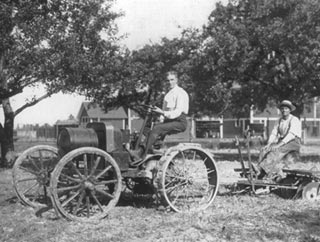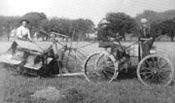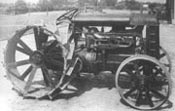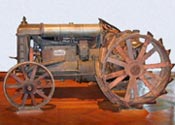 |
|
| |
|||||||
|
|||||||
|
|||||||
MORE: Henry Ford and the Fordson—A Model T for the Soil |
||||||
As a farm boy, Henry Ford disliked horses and the drudgery of farm labor. As an industrialist, he sought to improve the farmer's life through the mechanization of farm work. Beginning about 1906, Henry Ford directed his engineers to devise an agricultural tractor to replace the horse on the farm. At the time, most tractors weighed more than two tons and cost around $1,000. Henry Ford hoped to create a small, inexpensive tractor that most farmers could afford. Literally, a Model T for the soil. Ford tractors first saw service with Ford Motor
Company. In 1906 or 1907, according to Joseph Galamb, a Ford engineer,
Henry Ford asked him to build a light tractor to use with wheat production
and harvesting. Ford wanted the tractor built in three days. Though
he initially wanted the machine to pull a binder to cut and tie grain,
Ford later referred to this tractor as an “automotive plow.”
It was designed for pulling implements like plows, disc cultivators
and binders through the field. The engineers completed it in a week,
missing Ford’s three-day deadline.
In 1918, the United States Department of Agriculture authorized Henry Ford & Son to manufacture their Fordson tractor. The first commercial tractor off the line in Dearborn went to Ford’s friend, Luther Burbank. The Fordson became the dominant tractor of the early 1920s. It originally sold for $750.00, ran on kerosene, and weighed a little over a ton. By 1927, more than 750,000 Fordson tractors had been sold worldwide. American farmers embraced power farming. Seventy-five percent of the tractors in the United States were believed to be Fordsons. The Fordson realized Henry Ford’s dream of a lightweight, affordable tractor for the average farmer.
The tractor performed adequately at pulling a plow or powering a saw from its belt pulley, but Ford Motor Co. relied on other manufacturers to supply implements. The Fordson, or possibly Henry Ford’s own lack of flexibility caused the tractor to lose popularity to other tractors, especially the International Harvester Farmall. The Farmall had adjustable wheel widths to meet individual farmer’s preference for their crops, could power machinery while it pulled, and had a set of implements designed specifically for it by International Harvester. The Farmall set a new standard, as the Fordson had done before it.
|
| Copyright © The Henry Ford ~ http://www.TheHenryFord.org |




